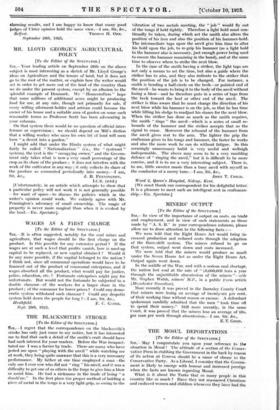THE BLACKSMITH'S STROKE
[To the Editor of the SPECTATOR.]
SIR, I regret that the correspondence on the blacksmith's stroke has only just come to my notice, but it has interested me to find that such a detail of the smith's craft should have had such interest for your readers. Before the War incapaci- tated me I was a farrier by trade. There are many who have jested me upon " playing with the anvil " while watching me at work, they being quite unaware that this is a very necessary performance. My father at one time employed a man—the only one I ever saw who did not " ring "'his anvil, and it was a difficulty to get one of us others in the forge to give him a blow or assist him. He had a nickname in the trade of being " a diunb'un." In the first place the proper method of holding a piece of metal in the tongs is a very light grip, as owing to the
vibration of two metals meeting, the " job " would fly out of the tongs if held tightly. Therefore a light hold must con- tinually be taken, during which act the smith also alters the position of his `iron and also the position of his hammer-hold. The intermediate taps upon the anvil giVe him time to alter his hold upon the job, to re-grip his hammer (as a light hold to the hammer also is necessary, just enough power being used to ensure the hammer remaining in the hand), and at the same time to observe where to strike the next blow.
In the case of the smith having a striker, the light taps are not only a means to set the time, but also a guide where the striker has to aim, and they also indicate to the striker that the position of the job is to be changed. For instance, a smith is bending a half-circle on the beck—or pointed end of the anvil—he wants to bring it to the body of the anvil without losing a blow—and he therefore puts in a series of taps from the beck toward the heel or other end of the anvil. The striker is thus aware that he must change the direction of his next blow while his hammer is on the job, so that he has time while lifting his sledge to readjust his stance for the next blow. When the striker has done as much as the smith requires, the smith " rings " the anvil—which is a series of small re- bounds of the hammer and the striker accepts that as the signal to cease. Moreover the rebound of the hammer from the anvil gives rest to the arm. The lighter the grip the craftsman gives to his tongs and hammer, the faster he works and also the more work he can do without fatigue. So this seemingly unnecessary habit is very useful and wellnigh indispensable. The above may seem to be a very rambling defence of " ringing the anvil," but it is difficult to be more concise, and it is to me a very interesting subject. There is, to me, little sweeter music than a busy anvil with myself as, the conductor of a merry tune.—I am, Sir, &c.,
[We must thank our correspondent for his delightful letter. It is a pleasure to meet such an intelligent zest in craftsman- ship.—En. Spectator.]


























































 Previous page
Previous page